Newcrest Mining Annual Report Analysis
VerifiedAdded on 2020/04/13
|13
|2234
|170
AI Summary
This assignment requires an in-depth analysis of Newcrest Mining's annual report. Students must examine the company's financial statements (Assets, Liabilities, Equity, Revenue, Expenses), corporate social responsibility initiatives, and future business strategies. The analysis should be grounded in accounting standards like IFRS and AASB, demonstrating a clear understanding of financial reporting principles.
Contribute Materials
Your contribution can guide someone’s learning journey. Share your
documents today.
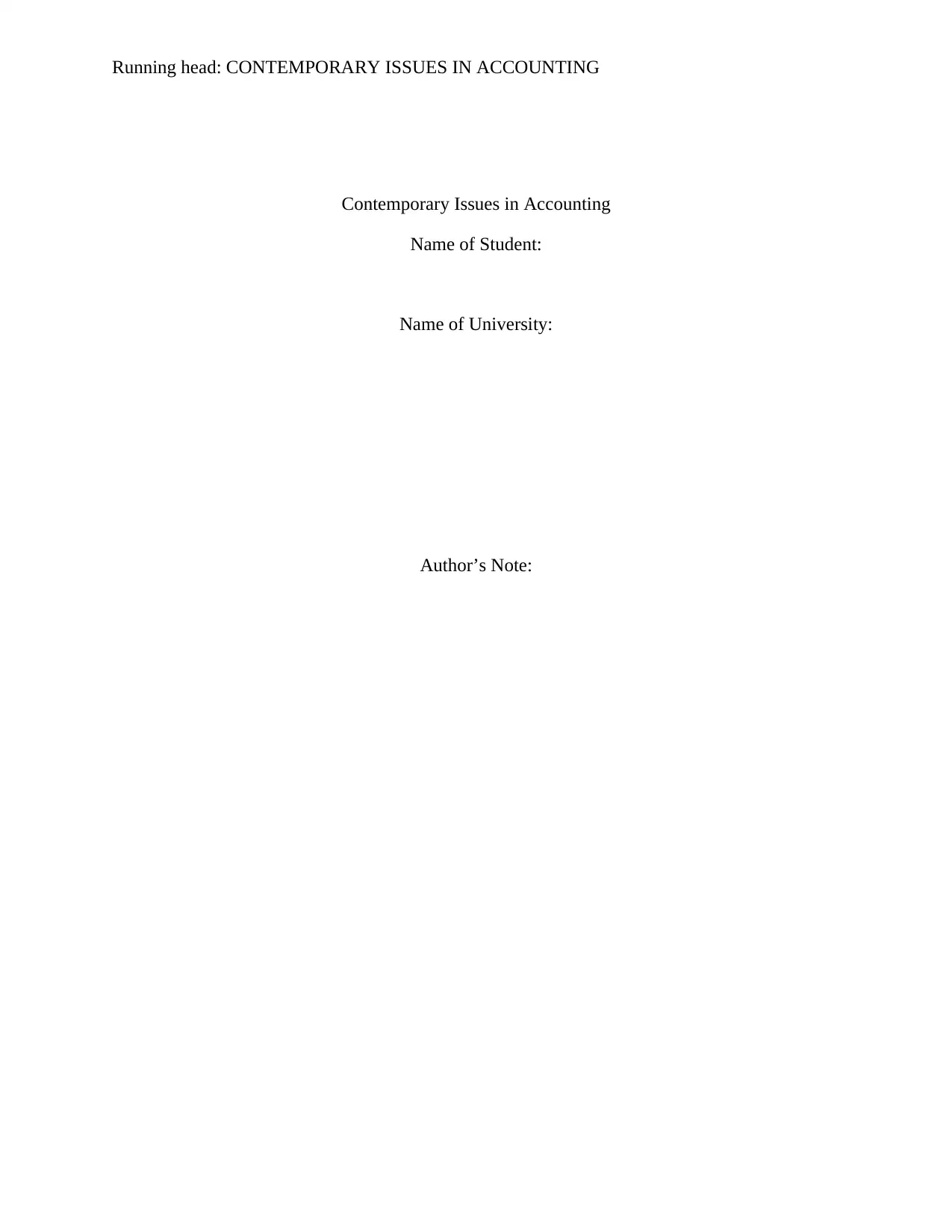
Running head: CONTEMPORARY ISSUES IN ACCOUNTING
Contemporary Issues in Accounting
Name of Student:
Name of University:
Author’s Note:
Contemporary Issues in Accounting
Name of Student:
Name of University:
Author’s Note:
Secure Best Marks with AI Grader
Need help grading? Try our AI Grader for instant feedback on your assignments.
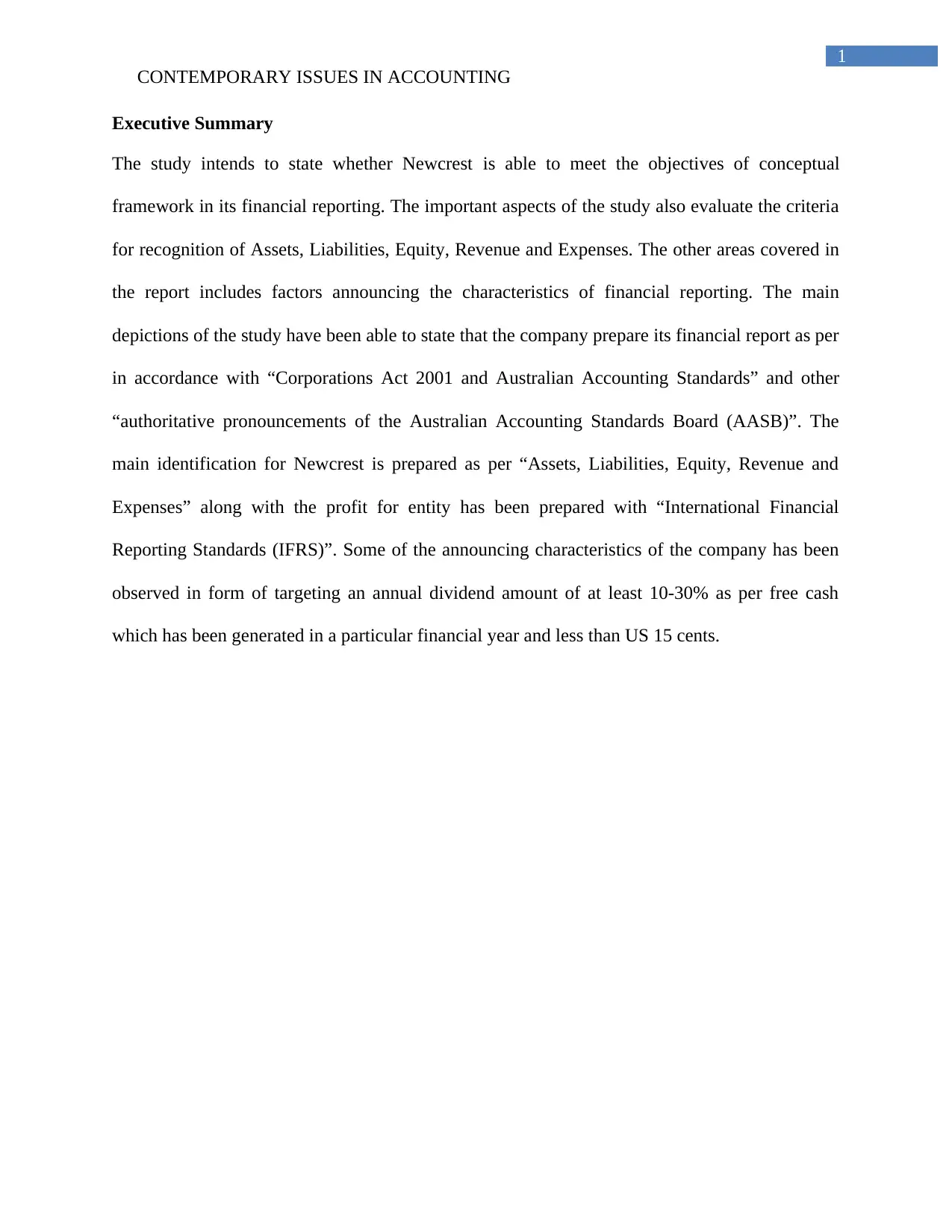
1
CONTEMPORARY ISSUES IN ACCOUNTING
Executive Summary
The study intends to state whether Newcrest is able to meet the objectives of conceptual
framework in its financial reporting. The important aspects of the study also evaluate the criteria
for recognition of Assets, Liabilities, Equity, Revenue and Expenses. The other areas covered in
the report includes factors announcing the characteristics of financial reporting. The main
depictions of the study have been able to state that the company prepare its financial report as per
in accordance with “Corporations Act 2001 and Australian Accounting Standards” and other
“authoritative pronouncements of the Australian Accounting Standards Board (AASB)”. The
main identification for Newcrest is prepared as per “Assets, Liabilities, Equity, Revenue and
Expenses” along with the profit for entity has been prepared with “International Financial
Reporting Standards (IFRS)”. Some of the announcing characteristics of the company has been
observed in form of targeting an annual dividend amount of at least 10-30% as per free cash
which has been generated in a particular financial year and less than US 15 cents.
CONTEMPORARY ISSUES IN ACCOUNTING
Executive Summary
The study intends to state whether Newcrest is able to meet the objectives of conceptual
framework in its financial reporting. The important aspects of the study also evaluate the criteria
for recognition of Assets, Liabilities, Equity, Revenue and Expenses. The other areas covered in
the report includes factors announcing the characteristics of financial reporting. The main
depictions of the study have been able to state that the company prepare its financial report as per
in accordance with “Corporations Act 2001 and Australian Accounting Standards” and other
“authoritative pronouncements of the Australian Accounting Standards Board (AASB)”. The
main identification for Newcrest is prepared as per “Assets, Liabilities, Equity, Revenue and
Expenses” along with the profit for entity has been prepared with “International Financial
Reporting Standards (IFRS)”. Some of the announcing characteristics of the company has been
observed in form of targeting an annual dividend amount of at least 10-30% as per free cash
which has been generated in a particular financial year and less than US 15 cents.
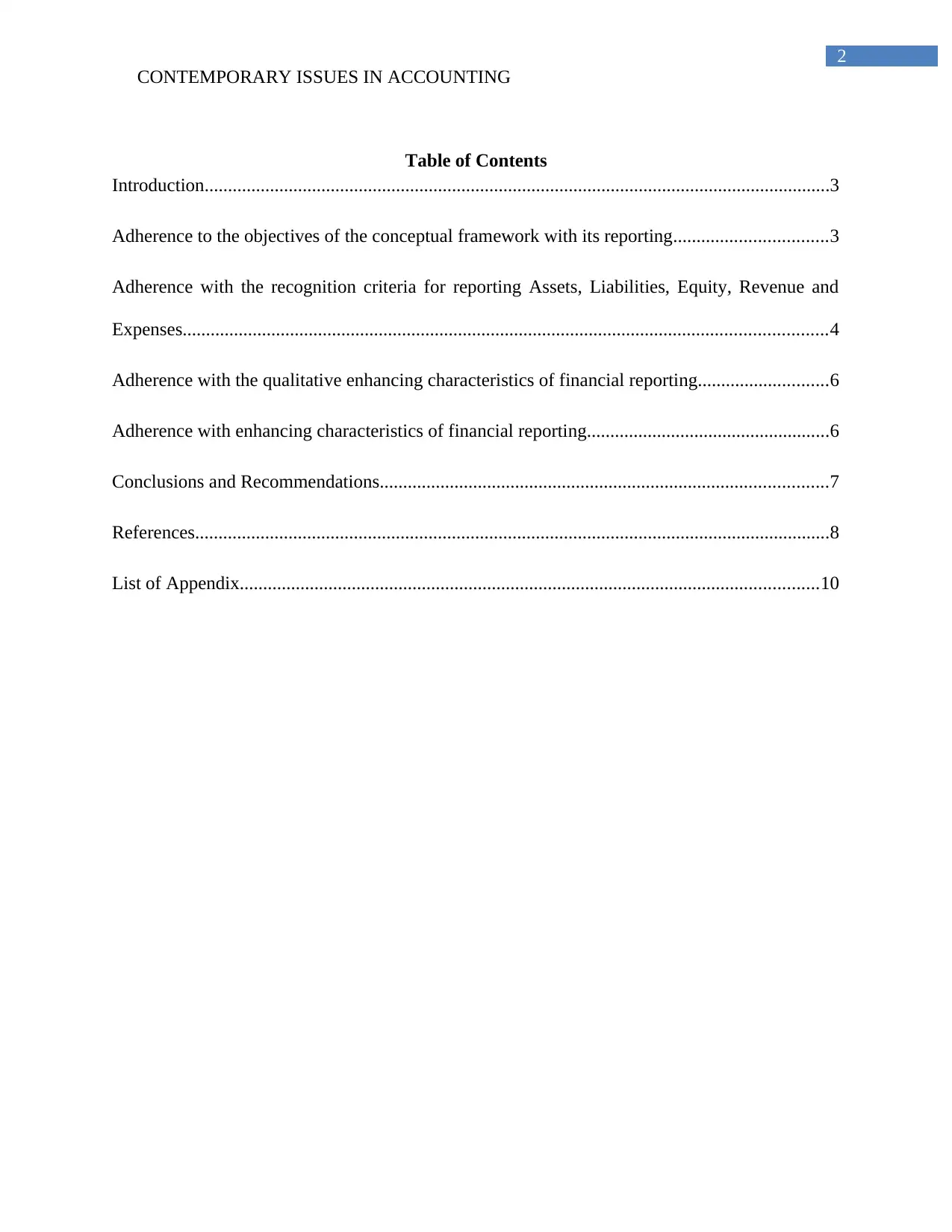
2
CONTEMPORARY ISSUES IN ACCOUNTING
Table of Contents
Introduction......................................................................................................................................3
Adherence to the objectives of the conceptual framework with its reporting.................................3
Adherence with the recognition criteria for reporting Assets, Liabilities, Equity, Revenue and
Expenses..........................................................................................................................................4
Adherence with the qualitative enhancing characteristics of financial reporting............................6
Adherence with enhancing characteristics of financial reporting....................................................6
Conclusions and Recommendations................................................................................................7
References........................................................................................................................................8
List of Appendix............................................................................................................................10
CONTEMPORARY ISSUES IN ACCOUNTING
Table of Contents
Introduction......................................................................................................................................3
Adherence to the objectives of the conceptual framework with its reporting.................................3
Adherence with the recognition criteria for reporting Assets, Liabilities, Equity, Revenue and
Expenses..........................................................................................................................................4
Adherence with the qualitative enhancing characteristics of financial reporting............................6
Adherence with enhancing characteristics of financial reporting....................................................6
Conclusions and Recommendations................................................................................................7
References........................................................................................................................................8
List of Appendix............................................................................................................................10
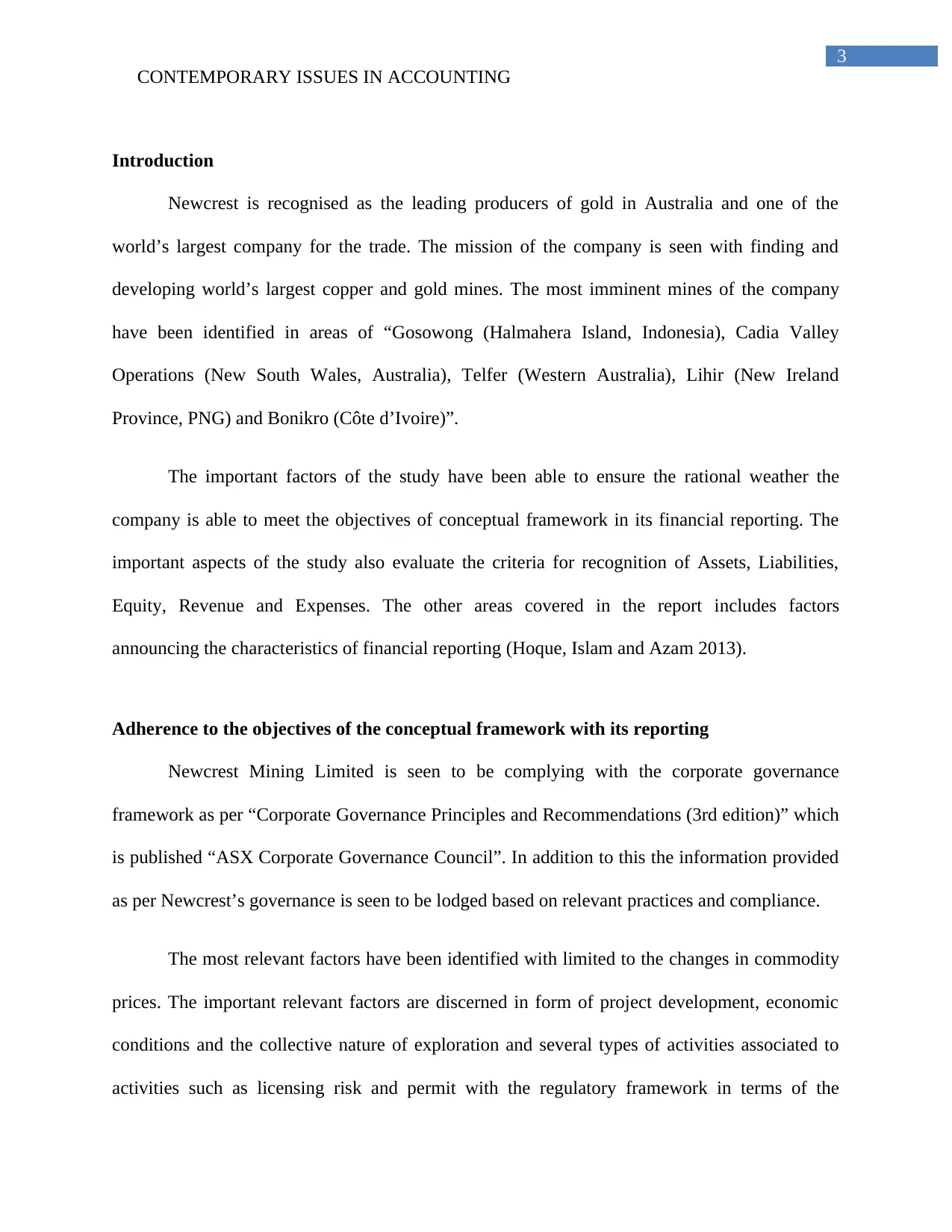
3
CONTEMPORARY ISSUES IN ACCOUNTING
Introduction
Newcrest is recognised as the leading producers of gold in Australia and one of the
world’s largest company for the trade. The mission of the company is seen with finding and
developing world’s largest copper and gold mines. The most imminent mines of the company
have been identified in areas of “Gosowong (Halmahera Island, Indonesia), Cadia Valley
Operations (New South Wales, Australia), Telfer (Western Australia), Lihir (New Ireland
Province, PNG) and Bonikro (Côte d’Ivoire)”.
The important factors of the study have been able to ensure the rational weather the
company is able to meet the objectives of conceptual framework in its financial reporting. The
important aspects of the study also evaluate the criteria for recognition of Assets, Liabilities,
Equity, Revenue and Expenses. The other areas covered in the report includes factors
announcing the characteristics of financial reporting (Hoque, Islam and Azam 2013).
Adherence to the objectives of the conceptual framework with its reporting
Newcrest Mining Limited is seen to be complying with the corporate governance
framework as per “Corporate Governance Principles and Recommendations (3rd edition)” which
is published “ASX Corporate Governance Council”. In addition to this the information provided
as per Newcrest’s governance is seen to be lodged based on relevant practices and compliance.
The most relevant factors have been identified with limited to the changes in commodity
prices. The important relevant factors are discerned in form of project development, economic
conditions and the collective nature of exploration and several types of activities associated to
activities such as licensing risk and permit with the regulatory framework in terms of the
CONTEMPORARY ISSUES IN ACCOUNTING
Introduction
Newcrest is recognised as the leading producers of gold in Australia and one of the
world’s largest company for the trade. The mission of the company is seen with finding and
developing world’s largest copper and gold mines. The most imminent mines of the company
have been identified in areas of “Gosowong (Halmahera Island, Indonesia), Cadia Valley
Operations (New South Wales, Australia), Telfer (Western Australia), Lihir (New Ireland
Province, PNG) and Bonikro (Côte d’Ivoire)”.
The important factors of the study have been able to ensure the rational weather the
company is able to meet the objectives of conceptual framework in its financial reporting. The
important aspects of the study also evaluate the criteria for recognition of Assets, Liabilities,
Equity, Revenue and Expenses. The other areas covered in the report includes factors
announcing the characteristics of financial reporting (Hoque, Islam and Azam 2013).
Adherence to the objectives of the conceptual framework with its reporting
Newcrest Mining Limited is seen to be complying with the corporate governance
framework as per “Corporate Governance Principles and Recommendations (3rd edition)” which
is published “ASX Corporate Governance Council”. In addition to this the information provided
as per Newcrest’s governance is seen to be lodged based on relevant practices and compliance.
The most relevant factors have been identified with limited to the changes in commodity
prices. The important relevant factors are discerned in form of project development, economic
conditions and the collective nature of exploration and several types of activities associated to
activities such as licensing risk and permit with the regulatory framework in terms of the
Secure Best Marks with AI Grader
Need help grading? Try our AI Grader for instant feedback on your assignments.
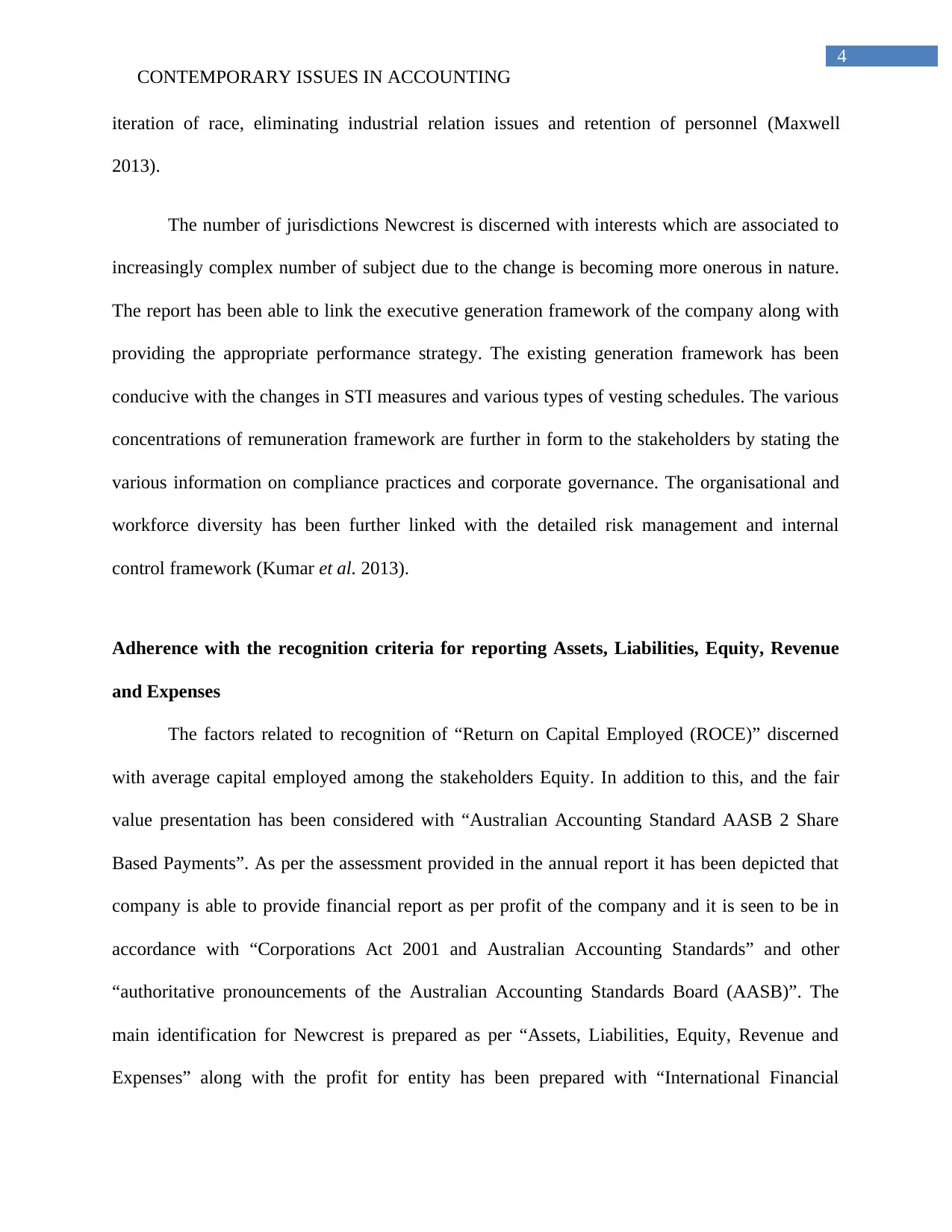
4
CONTEMPORARY ISSUES IN ACCOUNTING
iteration of race, eliminating industrial relation issues and retention of personnel (Maxwell
2013).
The number of jurisdictions Newcrest is discerned with interests which are associated to
increasingly complex number of subject due to the change is becoming more onerous in nature.
The report has been able to link the executive generation framework of the company along with
providing the appropriate performance strategy. The existing generation framework has been
conducive with the changes in STI measures and various types of vesting schedules. The various
concentrations of remuneration framework are further in form to the stakeholders by stating the
various information on compliance practices and corporate governance. The organisational and
workforce diversity has been further linked with the detailed risk management and internal
control framework (Kumar et al. 2013).
Adherence with the recognition criteria for reporting Assets, Liabilities, Equity, Revenue
and Expenses
The factors related to recognition of “Return on Capital Employed (ROCE)” discerned
with average capital employed among the stakeholders Equity. In addition to this, and the fair
value presentation has been considered with “Australian Accounting Standard AASB 2 Share
Based Payments”. As per the assessment provided in the annual report it has been depicted that
company is able to provide financial report as per profit of the company and it is seen to be in
accordance with “Corporations Act 2001 and Australian Accounting Standards” and other
“authoritative pronouncements of the Australian Accounting Standards Board (AASB)”. The
main identification for Newcrest is prepared as per “Assets, Liabilities, Equity, Revenue and
Expenses” along with the profit for entity has been prepared with “International Financial
CONTEMPORARY ISSUES IN ACCOUNTING
iteration of race, eliminating industrial relation issues and retention of personnel (Maxwell
2013).
The number of jurisdictions Newcrest is discerned with interests which are associated to
increasingly complex number of subject due to the change is becoming more onerous in nature.
The report has been able to link the executive generation framework of the company along with
providing the appropriate performance strategy. The existing generation framework has been
conducive with the changes in STI measures and various types of vesting schedules. The various
concentrations of remuneration framework are further in form to the stakeholders by stating the
various information on compliance practices and corporate governance. The organisational and
workforce diversity has been further linked with the detailed risk management and internal
control framework (Kumar et al. 2013).
Adherence with the recognition criteria for reporting Assets, Liabilities, Equity, Revenue
and Expenses
The factors related to recognition of “Return on Capital Employed (ROCE)” discerned
with average capital employed among the stakeholders Equity. In addition to this, and the fair
value presentation has been considered with “Australian Accounting Standard AASB 2 Share
Based Payments”. As per the assessment provided in the annual report it has been depicted that
company is able to provide financial report as per profit of the company and it is seen to be in
accordance with “Corporations Act 2001 and Australian Accounting Standards” and other
“authoritative pronouncements of the Australian Accounting Standards Board (AASB)”. The
main identification for Newcrest is prepared as per “Assets, Liabilities, Equity, Revenue and
Expenses” along with the profit for entity has been prepared with “International Financial
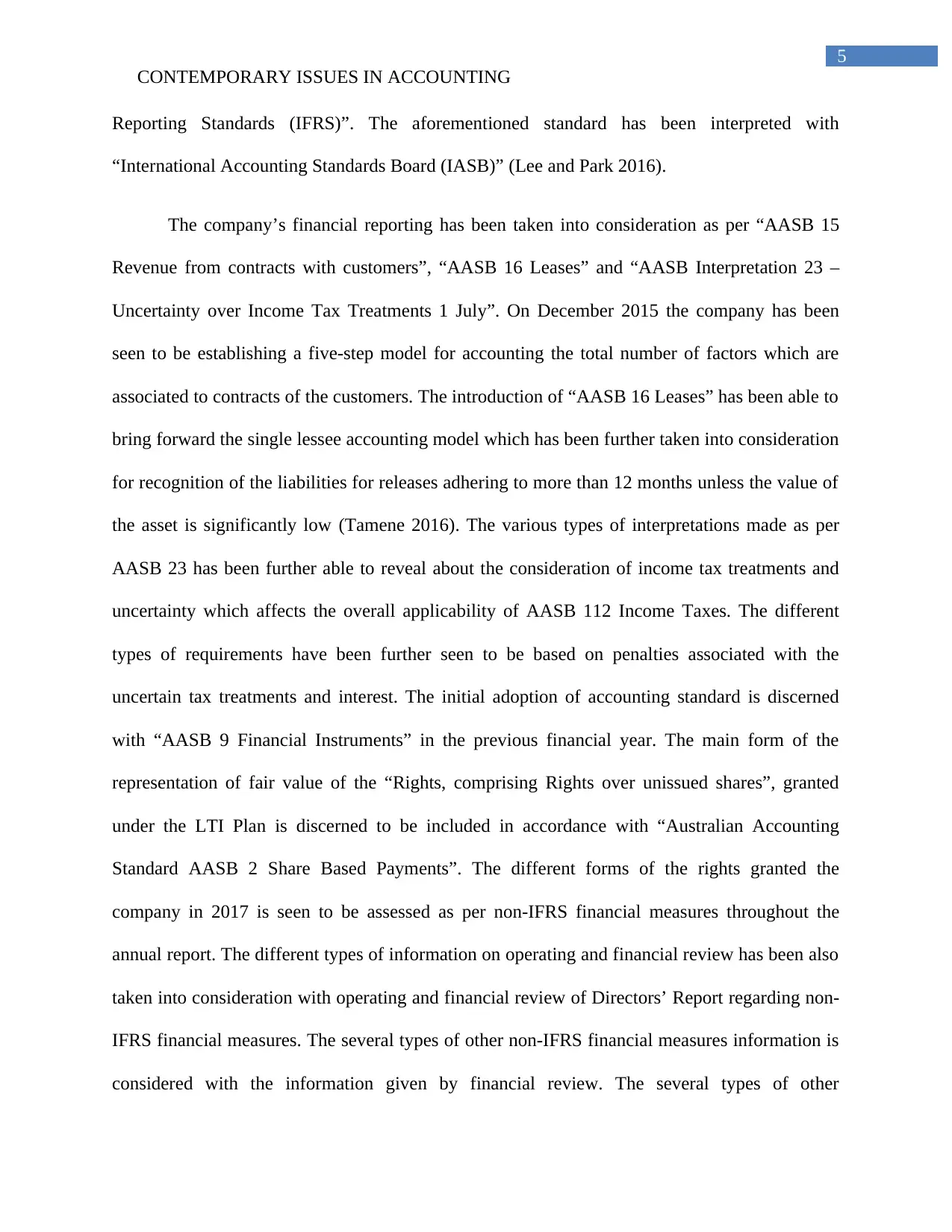
5
CONTEMPORARY ISSUES IN ACCOUNTING
Reporting Standards (IFRS)”. The aforementioned standard has been interpreted with
“International Accounting Standards Board (IASB)” (Lee and Park 2016).
The company’s financial reporting has been taken into consideration as per “AASB 15
Revenue from contracts with customers”, “AASB 16 Leases” and “AASB Interpretation 23 –
Uncertainty over Income Tax Treatments 1 July”. On December 2015 the company has been
seen to be establishing a five-step model for accounting the total number of factors which are
associated to contracts of the customers. The introduction of “AASB 16 Leases” has been able to
bring forward the single lessee accounting model which has been further taken into consideration
for recognition of the liabilities for releases adhering to more than 12 months unless the value of
the asset is significantly low (Tamene 2016). The various types of interpretations made as per
AASB 23 has been further able to reveal about the consideration of income tax treatments and
uncertainty which affects the overall applicability of AASB 112 Income Taxes. The different
types of requirements have been further seen to be based on penalties associated with the
uncertain tax treatments and interest. The initial adoption of accounting standard is discerned
with “AASB 9 Financial Instruments” in the previous financial year. The main form of the
representation of fair value of the “Rights, comprising Rights over unissued shares”, granted
under the LTI Plan is discerned to be included in accordance with “Australian Accounting
Standard AASB 2 Share Based Payments”. The different forms of the rights granted the
company in 2017 is seen to be assessed as per non-IFRS financial measures throughout the
annual report. The different types of information on operating and financial review has been also
taken into consideration with operating and financial review of Directors’ Report regarding non-
IFRS financial measures. The several types of other non-IFRS financial measures information is
considered with the information given by financial review. The several types of other
CONTEMPORARY ISSUES IN ACCOUNTING
Reporting Standards (IFRS)”. The aforementioned standard has been interpreted with
“International Accounting Standards Board (IASB)” (Lee and Park 2016).
The company’s financial reporting has been taken into consideration as per “AASB 15
Revenue from contracts with customers”, “AASB 16 Leases” and “AASB Interpretation 23 –
Uncertainty over Income Tax Treatments 1 July”. On December 2015 the company has been
seen to be establishing a five-step model for accounting the total number of factors which are
associated to contracts of the customers. The introduction of “AASB 16 Leases” has been able to
bring forward the single lessee accounting model which has been further taken into consideration
for recognition of the liabilities for releases adhering to more than 12 months unless the value of
the asset is significantly low (Tamene 2016). The various types of interpretations made as per
AASB 23 has been further able to reveal about the consideration of income tax treatments and
uncertainty which affects the overall applicability of AASB 112 Income Taxes. The different
types of requirements have been further seen to be based on penalties associated with the
uncertain tax treatments and interest. The initial adoption of accounting standard is discerned
with “AASB 9 Financial Instruments” in the previous financial year. The main form of the
representation of fair value of the “Rights, comprising Rights over unissued shares”, granted
under the LTI Plan is discerned to be included in accordance with “Australian Accounting
Standard AASB 2 Share Based Payments”. The different forms of the rights granted the
company in 2017 is seen to be assessed as per non-IFRS financial measures throughout the
annual report. The different types of information on operating and financial review has been also
taken into consideration with operating and financial review of Directors’ Report regarding non-
IFRS financial measures. The several types of other non-IFRS financial measures information is
considered with the information given by financial review. The several types of other
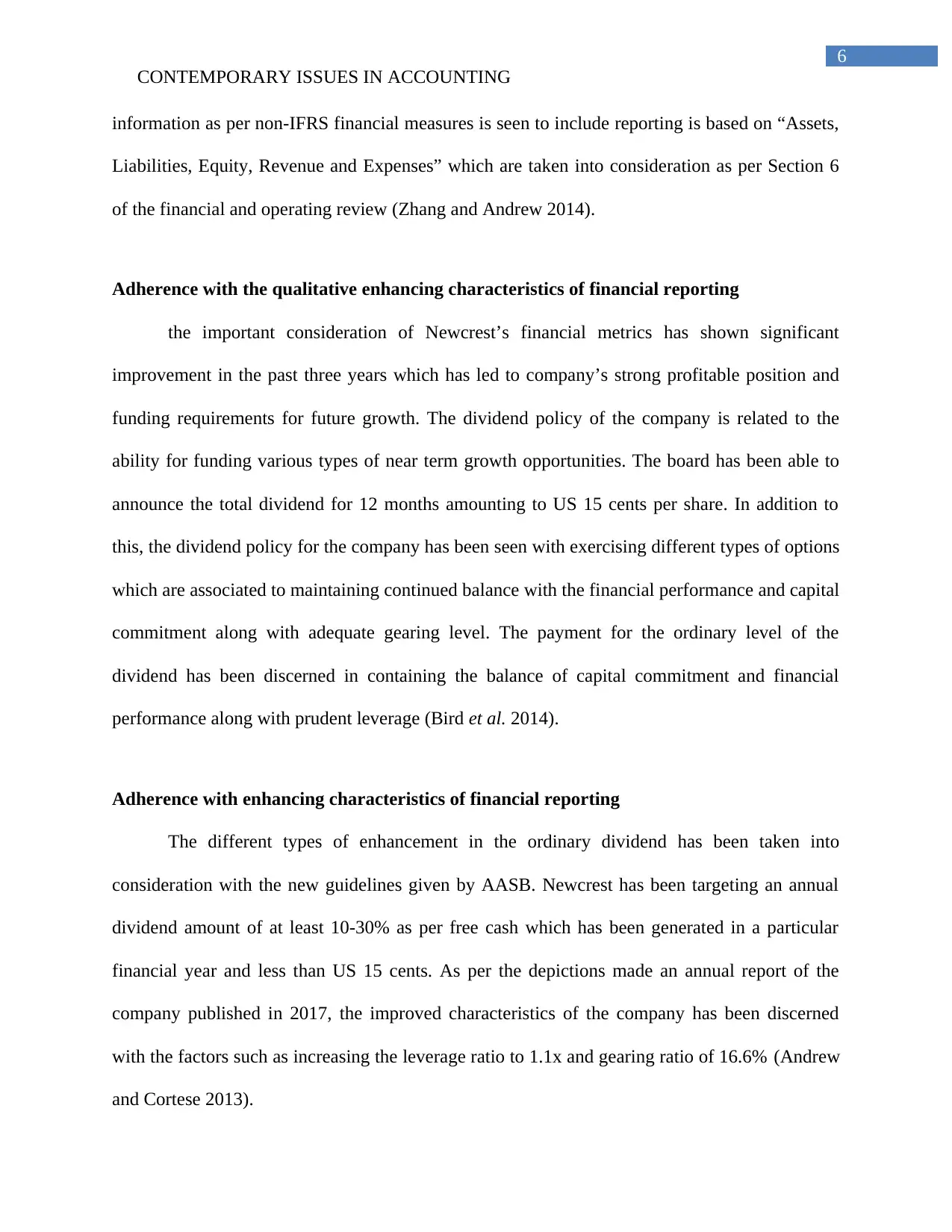
6
CONTEMPORARY ISSUES IN ACCOUNTING
information as per non-IFRS financial measures is seen to include reporting is based on “Assets,
Liabilities, Equity, Revenue and Expenses” which are taken into consideration as per Section 6
of the financial and operating review (Zhang and Andrew 2014).
Adherence with the qualitative enhancing characteristics of financial reporting
the important consideration of Newcrest’s financial metrics has shown significant
improvement in the past three years which has led to company’s strong profitable position and
funding requirements for future growth. The dividend policy of the company is related to the
ability for funding various types of near term growth opportunities. The board has been able to
announce the total dividend for 12 months amounting to US 15 cents per share. In addition to
this, the dividend policy for the company has been seen with exercising different types of options
which are associated to maintaining continued balance with the financial performance and capital
commitment along with adequate gearing level. The payment for the ordinary level of the
dividend has been discerned in containing the balance of capital commitment and financial
performance along with prudent leverage (Bird et al. 2014).
Adherence with enhancing characteristics of financial reporting
The different types of enhancement in the ordinary dividend has been taken into
consideration with the new guidelines given by AASB. Newcrest has been targeting an annual
dividend amount of at least 10-30% as per free cash which has been generated in a particular
financial year and less than US 15 cents. As per the depictions made an annual report of the
company published in 2017, the improved characteristics of the company has been discerned
with the factors such as increasing the leverage ratio to 1.1x and gearing ratio of 16.6% (Andrew
and Cortese 2013).
CONTEMPORARY ISSUES IN ACCOUNTING
information as per non-IFRS financial measures is seen to include reporting is based on “Assets,
Liabilities, Equity, Revenue and Expenses” which are taken into consideration as per Section 6
of the financial and operating review (Zhang and Andrew 2014).
Adherence with the qualitative enhancing characteristics of financial reporting
the important consideration of Newcrest’s financial metrics has shown significant
improvement in the past three years which has led to company’s strong profitable position and
funding requirements for future growth. The dividend policy of the company is related to the
ability for funding various types of near term growth opportunities. The board has been able to
announce the total dividend for 12 months amounting to US 15 cents per share. In addition to
this, the dividend policy for the company has been seen with exercising different types of options
which are associated to maintaining continued balance with the financial performance and capital
commitment along with adequate gearing level. The payment for the ordinary level of the
dividend has been discerned in containing the balance of capital commitment and financial
performance along with prudent leverage (Bird et al. 2014).
Adherence with enhancing characteristics of financial reporting
The different types of enhancement in the ordinary dividend has been taken into
consideration with the new guidelines given by AASB. Newcrest has been targeting an annual
dividend amount of at least 10-30% as per free cash which has been generated in a particular
financial year and less than US 15 cents. As per the depictions made an annual report of the
company published in 2017, the improved characteristics of the company has been discerned
with the factors such as increasing the leverage ratio to 1.1x and gearing ratio of 16.6% (Andrew
and Cortese 2013).
Paraphrase This Document
Need a fresh take? Get an instant paraphrase of this document with our AI Paraphraser
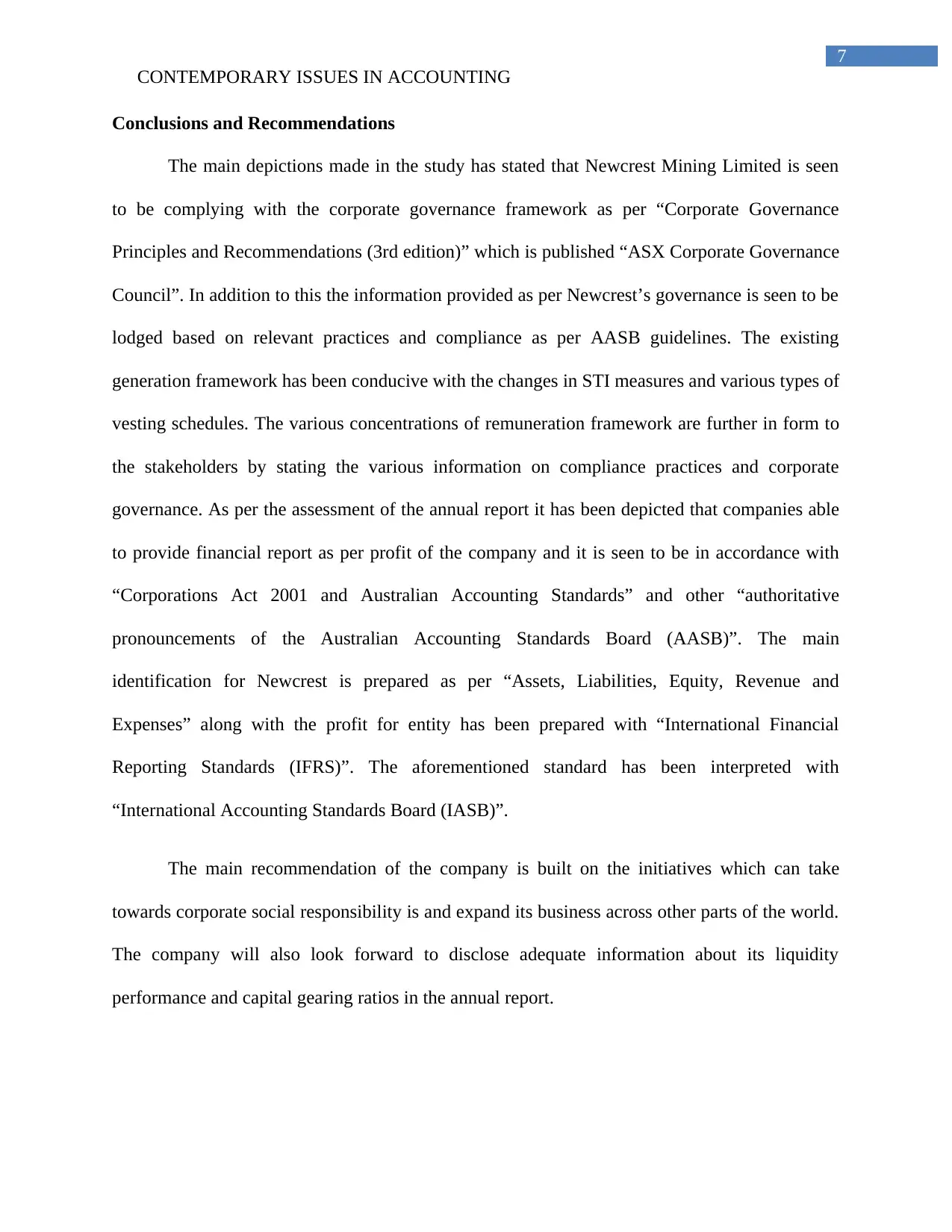
7
CONTEMPORARY ISSUES IN ACCOUNTING
Conclusions and Recommendations
The main depictions made in the study has stated that Newcrest Mining Limited is seen
to be complying with the corporate governance framework as per “Corporate Governance
Principles and Recommendations (3rd edition)” which is published “ASX Corporate Governance
Council”. In addition to this the information provided as per Newcrest’s governance is seen to be
lodged based on relevant practices and compliance as per AASB guidelines. The existing
generation framework has been conducive with the changes in STI measures and various types of
vesting schedules. The various concentrations of remuneration framework are further in form to
the stakeholders by stating the various information on compliance practices and corporate
governance. As per the assessment of the annual report it has been depicted that companies able
to provide financial report as per profit of the company and it is seen to be in accordance with
“Corporations Act 2001 and Australian Accounting Standards” and other “authoritative
pronouncements of the Australian Accounting Standards Board (AASB)”. The main
identification for Newcrest is prepared as per “Assets, Liabilities, Equity, Revenue and
Expenses” along with the profit for entity has been prepared with “International Financial
Reporting Standards (IFRS)”. The aforementioned standard has been interpreted with
“International Accounting Standards Board (IASB)”.
The main recommendation of the company is built on the initiatives which can take
towards corporate social responsibility is and expand its business across other parts of the world.
The company will also look forward to disclose adequate information about its liquidity
performance and capital gearing ratios in the annual report.
CONTEMPORARY ISSUES IN ACCOUNTING
Conclusions and Recommendations
The main depictions made in the study has stated that Newcrest Mining Limited is seen
to be complying with the corporate governance framework as per “Corporate Governance
Principles and Recommendations (3rd edition)” which is published “ASX Corporate Governance
Council”. In addition to this the information provided as per Newcrest’s governance is seen to be
lodged based on relevant practices and compliance as per AASB guidelines. The existing
generation framework has been conducive with the changes in STI measures and various types of
vesting schedules. The various concentrations of remuneration framework are further in form to
the stakeholders by stating the various information on compliance practices and corporate
governance. As per the assessment of the annual report it has been depicted that companies able
to provide financial report as per profit of the company and it is seen to be in accordance with
“Corporations Act 2001 and Australian Accounting Standards” and other “authoritative
pronouncements of the Australian Accounting Standards Board (AASB)”. The main
identification for Newcrest is prepared as per “Assets, Liabilities, Equity, Revenue and
Expenses” along with the profit for entity has been prepared with “International Financial
Reporting Standards (IFRS)”. The aforementioned standard has been interpreted with
“International Accounting Standards Board (IASB)”.
The main recommendation of the company is built on the initiatives which can take
towards corporate social responsibility is and expand its business across other parts of the world.
The company will also look forward to disclose adequate information about its liquidity
performance and capital gearing ratios in the annual report.
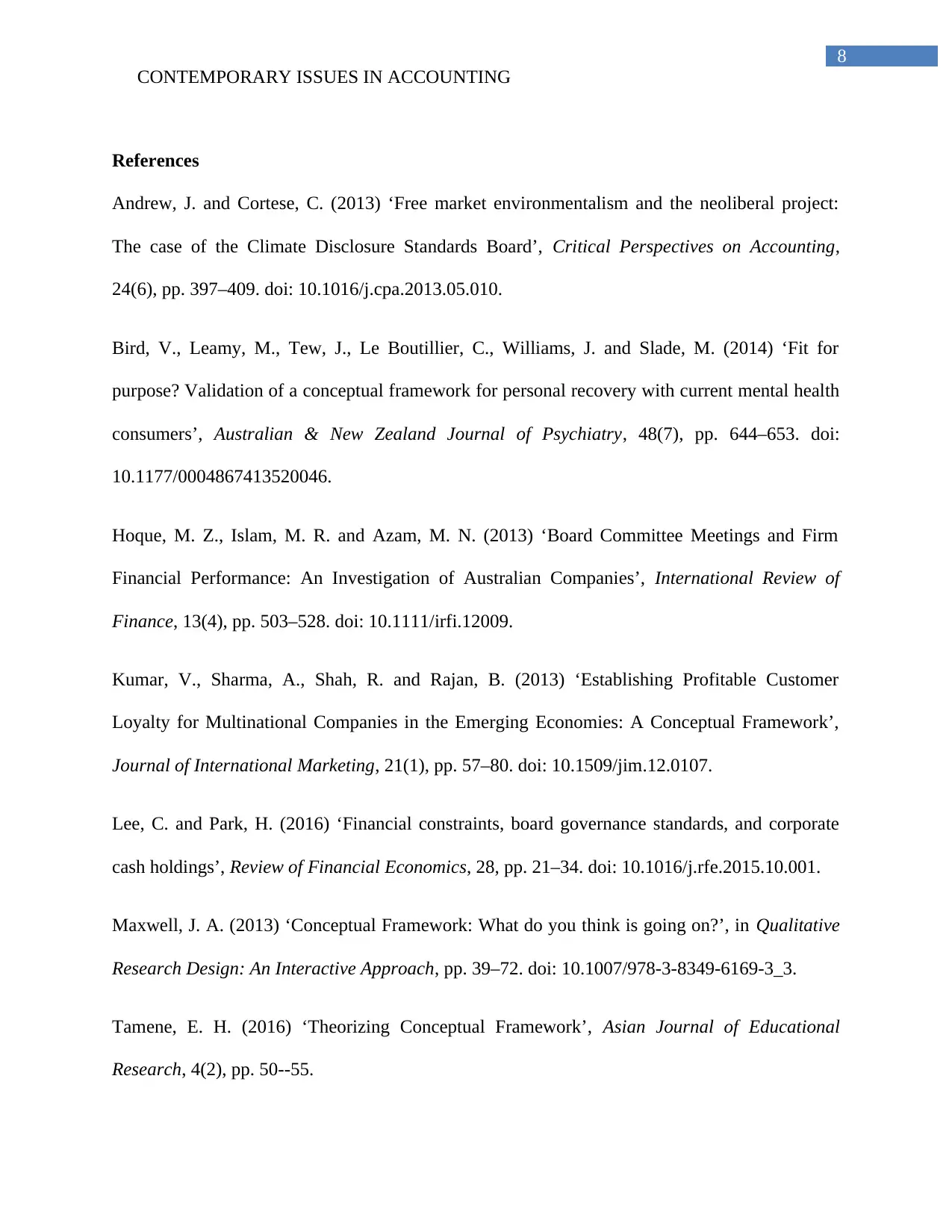
8
CONTEMPORARY ISSUES IN ACCOUNTING
References
Andrew, J. and Cortese, C. (2013) ‘Free market environmentalism and the neoliberal project:
The case of the Climate Disclosure Standards Board’, Critical Perspectives on Accounting,
24(6), pp. 397–409. doi: 10.1016/j.cpa.2013.05.010.
Bird, V., Leamy, M., Tew, J., Le Boutillier, C., Williams, J. and Slade, M. (2014) ‘Fit for
purpose? Validation of a conceptual framework for personal recovery with current mental health
consumers’, Australian & New Zealand Journal of Psychiatry, 48(7), pp. 644–653. doi:
10.1177/0004867413520046.
Hoque, M. Z., Islam, M. R. and Azam, M. N. (2013) ‘Board Committee Meetings and Firm
Financial Performance: An Investigation of Australian Companies’, International Review of
Finance, 13(4), pp. 503–528. doi: 10.1111/irfi.12009.
Kumar, V., Sharma, A., Shah, R. and Rajan, B. (2013) ‘Establishing Profitable Customer
Loyalty for Multinational Companies in the Emerging Economies: A Conceptual Framework’,
Journal of International Marketing, 21(1), pp. 57–80. doi: 10.1509/jim.12.0107.
Lee, C. and Park, H. (2016) ‘Financial constraints, board governance standards, and corporate
cash holdings’, Review of Financial Economics, 28, pp. 21–34. doi: 10.1016/j.rfe.2015.10.001.
Maxwell, J. A. (2013) ‘Conceptual Framework: What do you think is going on?’, in Qualitative
Research Design: An Interactive Approach, pp. 39–72. doi: 10.1007/978-3-8349-6169-3_3.
Tamene, E. H. (2016) ‘Theorizing Conceptual Framework’, Asian Journal of Educational
Research, 4(2), pp. 50--55.
CONTEMPORARY ISSUES IN ACCOUNTING
References
Andrew, J. and Cortese, C. (2013) ‘Free market environmentalism and the neoliberal project:
The case of the Climate Disclosure Standards Board’, Critical Perspectives on Accounting,
24(6), pp. 397–409. doi: 10.1016/j.cpa.2013.05.010.
Bird, V., Leamy, M., Tew, J., Le Boutillier, C., Williams, J. and Slade, M. (2014) ‘Fit for
purpose? Validation of a conceptual framework for personal recovery with current mental health
consumers’, Australian & New Zealand Journal of Psychiatry, 48(7), pp. 644–653. doi:
10.1177/0004867413520046.
Hoque, M. Z., Islam, M. R. and Azam, M. N. (2013) ‘Board Committee Meetings and Firm
Financial Performance: An Investigation of Australian Companies’, International Review of
Finance, 13(4), pp. 503–528. doi: 10.1111/irfi.12009.
Kumar, V., Sharma, A., Shah, R. and Rajan, B. (2013) ‘Establishing Profitable Customer
Loyalty for Multinational Companies in the Emerging Economies: A Conceptual Framework’,
Journal of International Marketing, 21(1), pp. 57–80. doi: 10.1509/jim.12.0107.
Lee, C. and Park, H. (2016) ‘Financial constraints, board governance standards, and corporate
cash holdings’, Review of Financial Economics, 28, pp. 21–34. doi: 10.1016/j.rfe.2015.10.001.
Maxwell, J. A. (2013) ‘Conceptual Framework: What do you think is going on?’, in Qualitative
Research Design: An Interactive Approach, pp. 39–72. doi: 10.1007/978-3-8349-6169-3_3.
Tamene, E. H. (2016) ‘Theorizing Conceptual Framework’, Asian Journal of Educational
Research, 4(2), pp. 50--55.
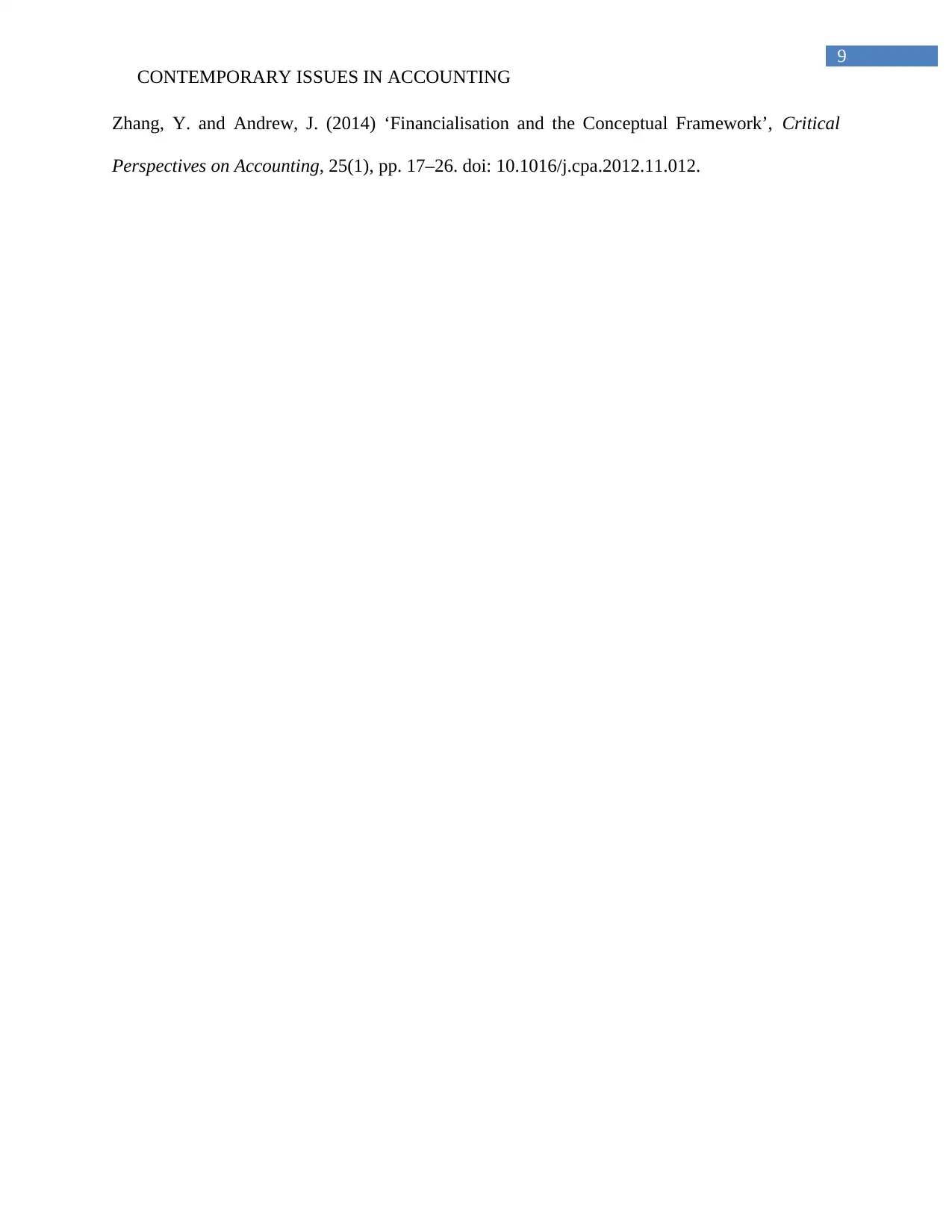
9
CONTEMPORARY ISSUES IN ACCOUNTING
Zhang, Y. and Andrew, J. (2014) ‘Financialisation and the Conceptual Framework’, Critical
Perspectives on Accounting, 25(1), pp. 17–26. doi: 10.1016/j.cpa.2012.11.012.
CONTEMPORARY ISSUES IN ACCOUNTING
Zhang, Y. and Andrew, J. (2014) ‘Financialisation and the Conceptual Framework’, Critical
Perspectives on Accounting, 25(1), pp. 17–26. doi: 10.1016/j.cpa.2012.11.012.
Secure Best Marks with AI Grader
Need help grading? Try our AI Grader for instant feedback on your assignments.
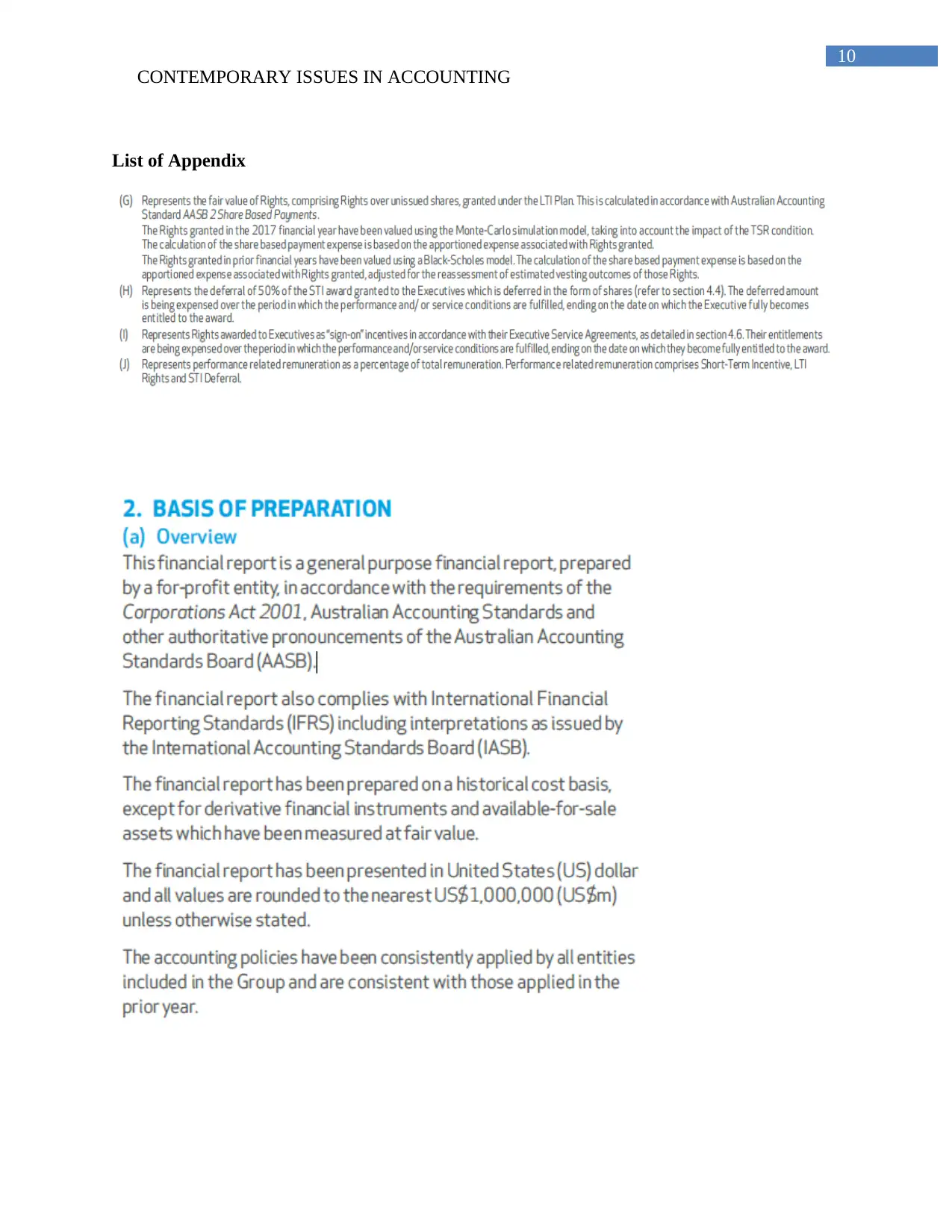
10
CONTEMPORARY ISSUES IN ACCOUNTING
List of Appendix
CONTEMPORARY ISSUES IN ACCOUNTING
List of Appendix
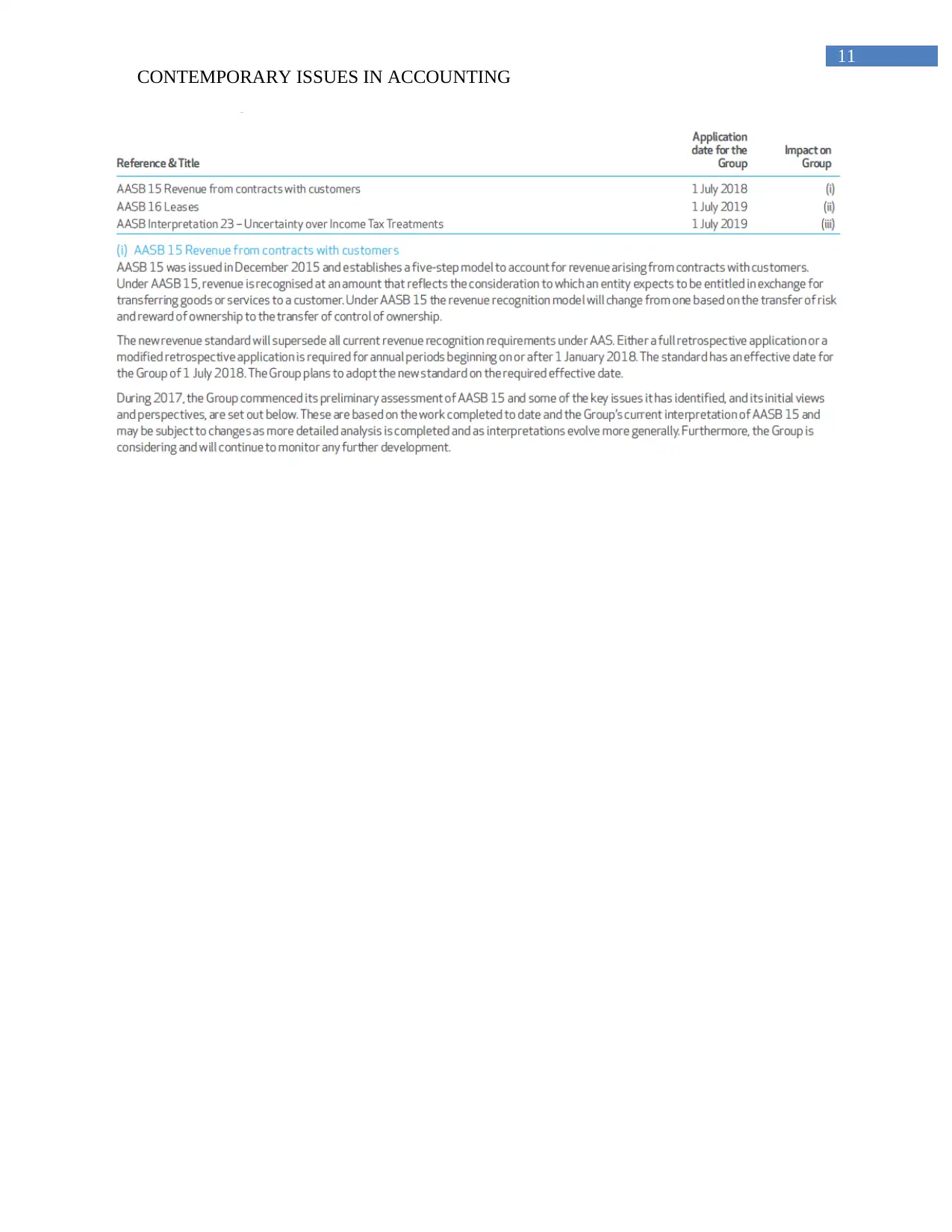
11
CONTEMPORARY ISSUES IN ACCOUNTING
CONTEMPORARY ISSUES IN ACCOUNTING
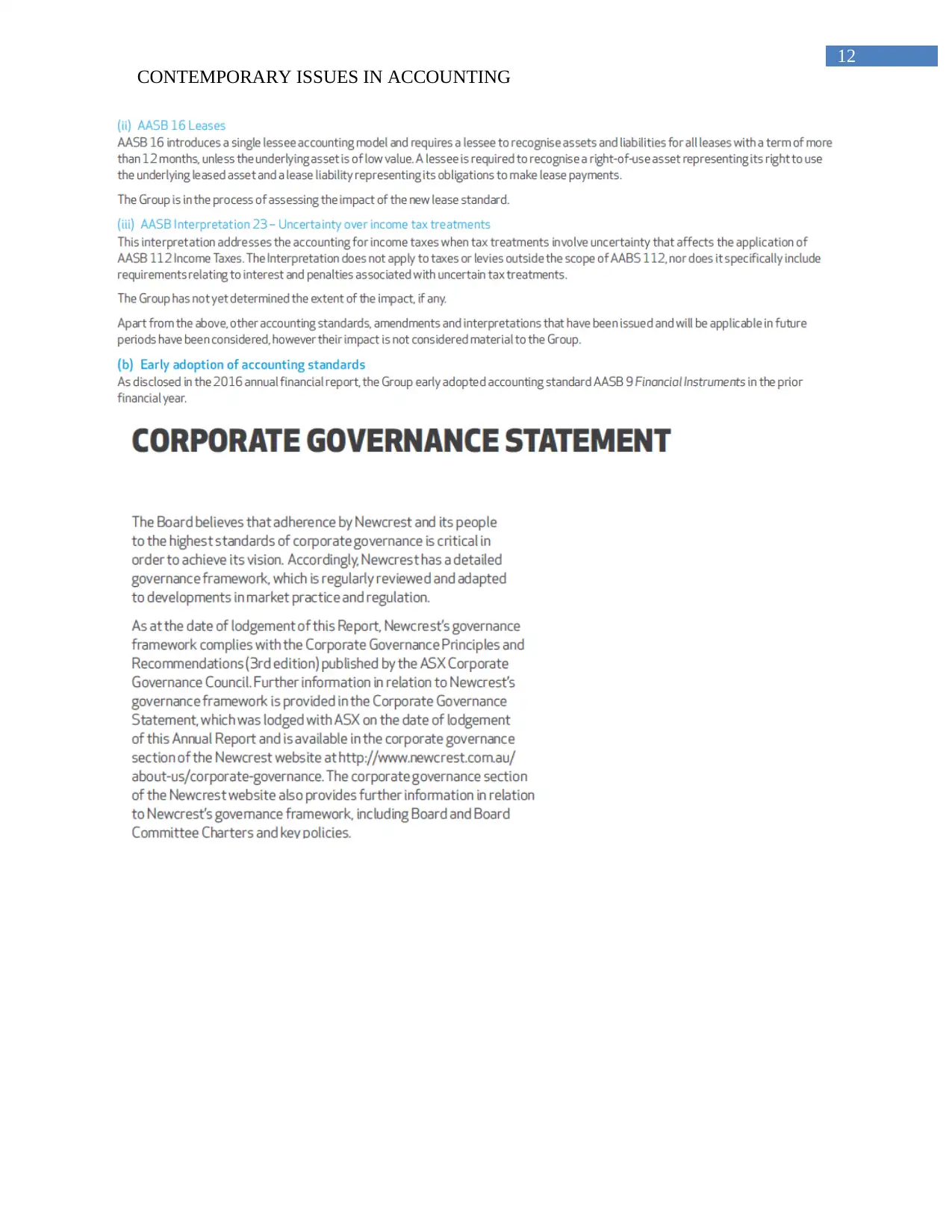
12
CONTEMPORARY ISSUES IN ACCOUNTING
CONTEMPORARY ISSUES IN ACCOUNTING
1 out of 13
Related Documents
Your All-in-One AI-Powered Toolkit for Academic Success.
+13062052269
info@desklib.com
Available 24*7 on WhatsApp / Email
![[object Object]](/_next/static/media/star-bottom.7253800d.svg)
Unlock your academic potential
© 2024 | Zucol Services PVT LTD | All rights reserved.

